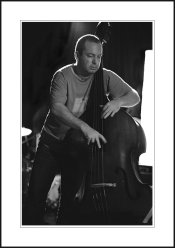Simplicius
Member
Neopan1600 pushed to 6400:
Background:
I was at a family wedding the weekend as a guest and normally never bother taking pictures inside but I had consumed some classic Black Photographic Developer during the evening. This of course is marketed as Guinness to the unsuspecting public and when mixed with a photographer tends to develop results that are irritating to relatives and lead to great high tension shots on peoples faces as they spot you looming towards them in the low light of the dance floor. Shutter speeds above 1/250 are recommended to negate the effect of sway when shooting. Overdoses can lead the individual to believe they are HCB or other great photographers whom they admire when sober.
Anyhow it has left me with a wee predicament I cranked the iso to 6400 as the lights were very low and went merrily through a roll. I want to of course see the results. They are not critical; there were professional photographers present so I am not terrified of loosing them.
Question:
Has anyone any experience of using Rodinal Special (Studional) on Fuji Neopan 1600 film to push it two stops? Any idea of times and agitation?
Here is my logic, I would normally dilute to 1:30 and double the recommended times agfa give for 1:15 dilution. It also seems like a minute a stop is average add on.
Fuji Neopan 1600 + Studional 1:15 @ 1600 = 3 mins
Fuji Neopan 1600 + Studional 1:30 @ 1600 = 6 mins
Plus to push two stops: Add 2 minutes and reduce agitation to gentle 5/min to keep grain down in size.
My research so far shows Neopan 1600 is an 800 film in reality and Xtol or Microphen are probably the best for pushing it. I have neither to hand. I have a 5L sachet of Xtol but dont really want to mix it up for a single film.
Any thoughts appreciated.
Background:
I was at a family wedding the weekend as a guest and normally never bother taking pictures inside but I had consumed some classic Black Photographic Developer during the evening. This of course is marketed as Guinness to the unsuspecting public and when mixed with a photographer tends to develop results that are irritating to relatives and lead to great high tension shots on peoples faces as they spot you looming towards them in the low light of the dance floor. Shutter speeds above 1/250 are recommended to negate the effect of sway when shooting. Overdoses can lead the individual to believe they are HCB or other great photographers whom they admire when sober.
Anyhow it has left me with a wee predicament I cranked the iso to 6400 as the lights were very low and went merrily through a roll. I want to of course see the results. They are not critical; there were professional photographers present so I am not terrified of loosing them.
Question:
Has anyone any experience of using Rodinal Special (Studional) on Fuji Neopan 1600 film to push it two stops? Any idea of times and agitation?
Here is my logic, I would normally dilute to 1:30 and double the recommended times agfa give for 1:15 dilution. It also seems like a minute a stop is average add on.
Fuji Neopan 1600 + Studional 1:15 @ 1600 = 3 mins
Fuji Neopan 1600 + Studional 1:30 @ 1600 = 6 mins
Plus to push two stops: Add 2 minutes and reduce agitation to gentle 5/min to keep grain down in size.
My research so far shows Neopan 1600 is an 800 film in reality and Xtol or Microphen are probably the best for pushing it. I have neither to hand. I have a 5L sachet of Xtol but dont really want to mix it up for a single film.
Any thoughts appreciated.














